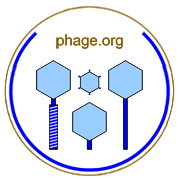

The plaques of phages that display a reduced efficiency of lysogenization; they in particular are mutants of temperate phages.
These clear plaques are formed on lawns consisting of either non-lysogens or heteroimmune lysogens, though a subset of such mutants are able to form clear plaques (indeed, are able to form plaques) on otherwise homoimmune lysogens. See virulent mutant as well as intemperate for additional discussion.
The turbidity of plaques formed by wild-type temperate phages are a consequence of microcolony formation by lysogens that grow over the course of plaque formation. Phages that are unable to form lysogens thus fail to produce these phage-resistance (i.e., phage-immune) microcolonies and as a consequence remain clear. From the glossary of The Bacteriophage Lambda (1971) (p. 773) note also this definition of "clear" (as in, "clear" plaque): "Lambda and other temperate phages form plaques that are turbid owing to growth of cells surviving the infection. Mutants forming clear plaques (clear mutants) establish immunity less efficiently and permit fewer cells to survive."
From Ptashne, M. (2004, A Genetic Switch: Phage Lambda Revisited, 3/e, Cold Spring Harbor Press, Cold Spring Harbor, NY) (p. 68): "Most of these clear mutants bear a lesion in one of three genes: cI, cII, or cIII. It is possible to isolate a rare lysogen of a cII or cIII mutant; once isolated the lysogen is stable, immune, and inducible by ultraviolet light. But it is never possible to isolate a lysogen of a cI mutant."
For more on this topic, see Wikipedia, Google, and PubMed. Contact web master. Return to terms.











